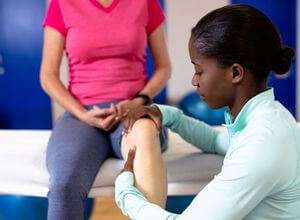If you’re an athlete or have an active lifestyle, you might have already experienced needing professional physical therapy to help you recuperate. Many things influence how likely that is, yet even little aches and pains might catch us off guard. Fortunately, discomfort normally passes, but a physical therapist can really help if it doesn’t.
Professional physical therapy assists patients in all stages of rehabilitation, from initial diagnosis through restorative and preventative therapy. Professional physical therapy can be used alone or in conjunction with other therapies.
Some of the patients are referred to a physical therapist by their doctor, while others seek treatment independently.

A physical therapist, according to the World Confederation for Physical Therapy, obtains training that allows them to:
- Conduct a physical exam and examination of a person’s mobility, flexibility, muscle and joint motion, and performance, as well as learn about their medical history
- Provide a clinical diagnosis, prognosis, and treatment plan with short- and long-term objectives
- Give treatment and intervention in physical therapy
- Provide ideas for self-management, including activities that may be done at home
Professional physical therapy treatment may include, in addition to physical manipulation:
- Iontophoresis: This technique employs an electrical current to administer drugs such as topical steroids. This has the potential to reduce the presence of inflammation.
- Electrical stimulation (e-stim) is classified into two categories. Pain is reduced with transcutaneous electrical nerve stimulation. On the other hand, neuromuscular electrical stimulation seeks to activate muscle motor units to increase muscular engagement.
- Heat, moist heat, and cold treatment may benefit various illnesses.
- Light therapy uses special lights and lasers to treat certain medical ailments.
When is Professional Physical Therapy Necessary?
If you’re experiencing any of the following signs or symptoms, you should consult your primary care physician to evaluate whether a professional physical therapy referral is required.
Sharp Ache
In most situations, an ice pack and rest relieve dull discomfort. On the other hand, localized, intense pain might result from a stress cause or muscular strain. If you do not treat the underlying injury causing the acute, abrupt pain, the discomfort may not go away. Working with a physical therapist may be your greatest choice for long-term recovery.
Persistent Pain

It is natural to have soreness after a tough workout. Rest should take care of this, but if you’re still in pain after using an ice pack and resting for a few days, it’s time to look into professional physical therapy. If you experience persistent discomfort, consult your doctor, who may refer you to a physical therapist.
Trauma and Injury
Professional physical therapy can help with sudden or catastrophic injuries. Two of the most frequent injuries addressed by physical therapists are muscle rips and shattered bones. When you suffer unexpected trauma, it is critical to address the immediate situation so that it does not worsen further down the line.
Medication For Pain Is Ineffective
Your primary care physician may prescribe pain medication to relieve pain and suffering. Of course, if the discomfort persists after pain treatment, it may be time to seek a referral for professional physical therapy.
Noticeable Changes in the Body
The fact is that only you understand your body. If you detect any physical changes in your body, especially in regions where you are suffering discomfort, make an appointment with your doctor. Working with a physical therapist may be beneficial if you are suffering unexpected discomfort and localized pain.
Types Of Professional Physical Therapy
There are several forms of professional physical therapy that therapists frequently specialize in. These are some examples:
Orthopedic physical therapy treats injuries to the muscles, bones, ligaments, fascia, and tendons. It can help with fractures, sprains, tendinitis, bursitis, chronic health issues, and rehabilitation or recovery following orthopedic surgery. Joint mobilization, manual therapy, strength training, mobility training, and other modalities may be used to treat patients.
Geriatric physical therapy can help older persons with mobility and physical function issues, such as arthritis, osteoporosis, Alzheimer’s disease, hip and joint replacement, balance abnormalities, and incontinence. This intervention seeks to restore mobility, alleviate pain, and improve physical fitness.
People with neurological diseases such as Alzheimer’s, brain damage, cerebral palsy, multiple sclerosis, Parkinson’s, spinal cord injury, and stroke can benefit from neurological physical therapy. Treatment may enhance limb response, movement patterns, tone management, strength, and balance.
Cardiovascular and pulmonary rehabilitation can help persons afflicted by certain cardiopulmonary illnesses or surgical operations. Treatment has been shown to improve muscular and cardiovascular endurance and stamina.

Wound care therapy: Improved circulation can guarantee that a healed wound receives enough oxygen and blood. Manual treatments, e-stim, compression therapy, and wound care may all be used in physical therapy.
Vestibular treatment is used to address balance issues caused by inner ear diseases. Vestibular physical therapy consists of various exercises and manual techniques to help patients restore their balance and coordination. Decongestive treatment: This can help patients with lymphedema and other disorders that involve fluid buildup and drain collected fluid.
Pelvic floor rehabilitation can aid in treating diseases affecting the pelvic floor, such as urine or fecal incontinence, urinary urgency, and pelvic discomfort resulting from trauma, surgery, or other factors.
What Benefits Does Professional Physical Therapy Provide?
Your doctor may recommend professional physical therapy if you have a medical condition, disease, or accident. As a patient, you may wonder, “Do I need professional physical therapy?” In the majority of circumstances, the answer is yes. You can reap the following benefits by making the time and effort to see a physical therapist regularly.
Relieve Pain
If you are in pain, a physical therapist can use manual therapy such as soft tissue mobilization, ultrasound, or taping to relieve discomfort and improve muscle and joint function. A physical therapist can assist in alleviating pain and keep it from returning.
Avoid Surgical Procedures
Your doctor may recommend professional physical therapy to determine if it might improve or eliminate your issue. If it can, you may be able to avoid the needles, anesthesia, and downtime associated with surgery. If you need surgery, you’ll be in better form, lowering the chance of problems and speeding up your recovery.
Increase Mobility
If you’re experiencing trouble walking, standing, or moving about, physical therapy exercises may be precisely what’s needed for you to get back on your feet. A physical therapist can build a tailored treatment plan to safely and efficiently increase your mobility, regardless of age or present physical status.
Age-related Difficulties
You may notice a distinct set of physical problems as you age. For example, you could find it difficult to go up and down the stairs or carry your groceries around the home. A physical therapist could help you develop an exercise plan to keep you safe and strong. With their help, you may lower your chance of falling, maintain your balance, enhance your coordination, and gain flexibility, strength, and range of motion.
How to Recover from a Sports Injury

Professional physical therapy could help you recover from a sports injury. Why? Because physical therapists understand how different sports might increase your risk of particular injury kinds. They can design a rehabilitation workout regimen for you so that you may safely return to your sport.
Rehabilitate
Rehabilitation is to improve or restore your function and quality of life. Following a heart attack or cancer, your doctor may advise you to pursue rehabilitation. They may also recommend it if you have a disease such as arthritis, muscular dystrophy, or fibromyalgia.
When Should I Begin Physical Therapy Following An Injury?
Patients can drastically minimize their risk of future problems and, in some situations, even shorten their recovery time by beginning adequate professional physical therapy as soon as it is safe and practical after an accident occurs. Our skilled staff will offer a personalized treatment plan for you based on the nature and severity of your injury. If necessary, physical treatment may begin as soon as a few days following the accident. When patients postpone professional physical therapy, their injuries and symptoms typically worsen, making treatment more difficult and expensive. When delayed or denied physical treatment, patients might suffer lasting nerve damage, limited range of motion, and other consequences.
Is Professional Physical Therapy Truly Beneficial?
One common objective of professional physical therapy is to meet the patient’s rehabilitation requirements by teaching self-treatment principles to assist control symptoms and learning how to avoid future damage. Professional physical therapy can help many people heal from injuries and damages while attaining long-term effects. Call us today to learn more!

